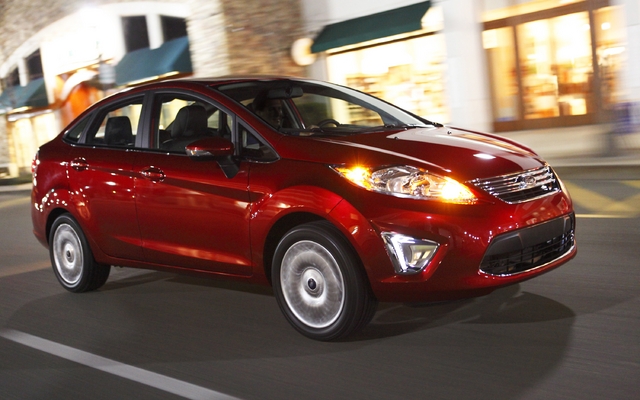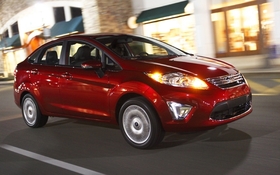The 2011 Ford Fiesta: The Perfect Car?
Occasionally, a car comes along that absolutely blows you away. For example; the first time I experienced precisely how explosive a 600 horsepower Dodge Viper can be is a memory that I’ll not soon forget. Likewise, the awe-inspiring all-around performance of Porsche’s latest 911 Turbo left me absolutely floored. Nissan’s GTR, although tested in perhaps the most sodden, abhorrent conditions imaginable, impressed with its sure-footedness and seemingly complete inability to do wrong. So imagine my surprise, then, when a subcompact sedan managed to trump absolutely everything and anything I’d ever driven.
Sure, it might sound like hyperbole at best and derriere-kissing vitriol at worst, but the reality is that it’s entirely true. I was all too willing to be critical of the overwhelming wave of positive press the diminutive sedan generated (after all, there was a similar wave of support when the Chevy Malibu Hybrid popped up on the radar too, and look where that car is now… for good reason), and perfectly willing to chalk it all up to the automotive press’ fascination with any and all things European. But I stand here now, dear reader, happily corrected.
Handed the keys to a relatively low-key SEL sedan, I was at first surprised by how sedate the car appeared. Having acquainted myself with the various press materials and pre-existing reviews, I’d assumed that all Fiestas came in lively and bright colours like the greens and oranges populating most photos. However, once I took a closer look I noticed a few nice exterior touches that certainly helped separate this car from its rivals. The first and foremost of these touches are the chrome-trimmed white LED light tubes running vertically down the sides of the front bumper. Since I rarely get to see the front of one of my press cars while it’s running down the road, these nifty little lights went unnoticed by yours truly for days, until I ended up following a black pickup truck down the highway and noticed their reflection in the tailgate. Adding a heady degree of luxuriousness and upper trim level pizzazz to an already good looking car, they quickly became one of my favourite Fiesta selling features.
As I mentioned though, there are a few other nice features that you’re not liable to find on other subcompact sedans; like the gorgeous 16” painted split-spoke wheels and exquisite quality control that’s apparent in the body’s assembly. Although manufacturers have gotten pretty good at ensuring uniform panel fitment by now, the Fiesta stands out for the overall attention to detail that’s been paid to its smaller trim pieces, like the perfectly set grill and trim bezels. On my top-trim sedan, that meant the three-bar chrome grille (coincidentally, that’s a feature that’s sedan-specific, with the Fiesta hatchback getting a more European-styled, colour-matched slot-style grille) maintained perfect spacing between it and the surrounding urethane bumper as did the chrome trim ring that surrounds the lower fascia opening. Although these may sound like trivial things, they’re not something I’ve often seen on cars in this price range, and they will help keep these cars looking good for years to come as improper fitment can lead to chipping of the chrome coated plastic and scratched bodywork.
|
Inside, however, there’s nothing trivial about its unparalleled excellence. Although Honda’s Fit comes close, the Fiesta stands alone as the airiest of the subcompacts and the small sedan really does channel Alec Issigonis’ original Mini in terms of feeling much larger than its outward appearance belies. There are some oddities though, especially if you’re well acquainted with Ford’s North American products. First off, there’s the console. Gone is the familiar horizontal layout found in nearly every Ford truck and car for years, replaced by a Volvo-esque and very European shaped control cluster that it fitted perfectly to the Fiesta’s dash. Sitting directly below the equally new and unfamiliar red-only display, the audio and entertainment controls are divided by a four way selector switch, seek controls, and a volume knob. Below that, sitting just below the dashboard, reside the more familiar heater controls. Even the turn signal and wiper stalks are quite differently shaped than the typical Fords’.
But that’s not to say they don’t work well. Once I’d gotten acquainted to the various controls and their locations, changing things like audio settings, radio stations, wiper frequency and cruise control speed all became quite easy. However, there was one frustrating fly in the ointment: the iPod connectivity. As someone that prefers podcasts over the radio, I expected to use Ford’s excellent Sync system to control my mobile devices… and I did. It may have taken a while to find the voice command button (it’s on the left side steering column stalk), but the system responded just as well as every other Sync system’s voice recognition system had thereafter. But if I, or my passengers, ever wanted to scroll though iPod playlists, the result would invariably be pure and unadulterated rage as the system does not seem to have any provision for displaying the available content in a normal list layout.
Which is quite odd, given the amount of thought that seems to have gone into the remainder of the interior. For example, the windshield is manufactured from sound-deadening glass, and works phenomenally well. As a denizen of one of Vancouver’s many outlying suburban sprawls, I spend more than my fair share of time cruising down the highway at 110 kilometres per hour, and I was pleasantly surprised… nay, flabbergasted, by the Fiesta’s high speed performance and solidarity. I’ve generally considered subcompacts to be quite good in urban areas, and merely passable on long highway expeditions. Their combination of small size, small tires, small engines, and small price tags usually ensures a noisy, buzzy ride that’s easily buffeted around and lacks the power to pass commercial traffic. I couldn’t have been more wrong when it came to the Fiesta. With a six speed dual clutch gearbox and plenty of sound deadening, the engine’s enthusiastic efforts were barely perceptible from within the cabin; only breaching the quietness when called upon to merge or during passing maneuvers; both tasks that it was more than capable of. Even humming along at U.S. speed limits, the car never felt as if it was straining to maintain its speed, and really instilled a lot more confidence than any other subcompact I’ve driven.
And that’s why this is the single most impressive car I’ve ever driven. At no point during my week’s test did the Fiesta ever feel like a “cheap” car, and yet it is. As the topmost sedan, mine tipped the scales at just over $21,000, and yet I’d consider it equal to cars costing twice as much. It’s enviably capable, packed with high-end technology like its unique dual clutch gearbox and Sync system, and impressively luxurious. The interior is hushed and incredibly well executed, and packed with materials and textures that are light years ahead of those offered by its competitors. The spacious interior, massive trunk, and sublime road manners seem to be have more in common with vastly more expensive and far larger vehicles, but even ignoring the Fiesta’s subcompact boundaries can’t dull its luster. Rather, pitting it against such vehicles as Toyota’s Camry and Honda’s Accord simply makes it seem that much more impressive. Feeling better built than even those incredibly popular family sedans, the Fiesta’s value seems limitless; giving buyers a nearly faultless car that’s more economical, more fun, and equally practical for almost half the money. Although it may fill Ford’s small-car niche, the diminutive new Fiesta is probably the single best reason to buy a new car today.












